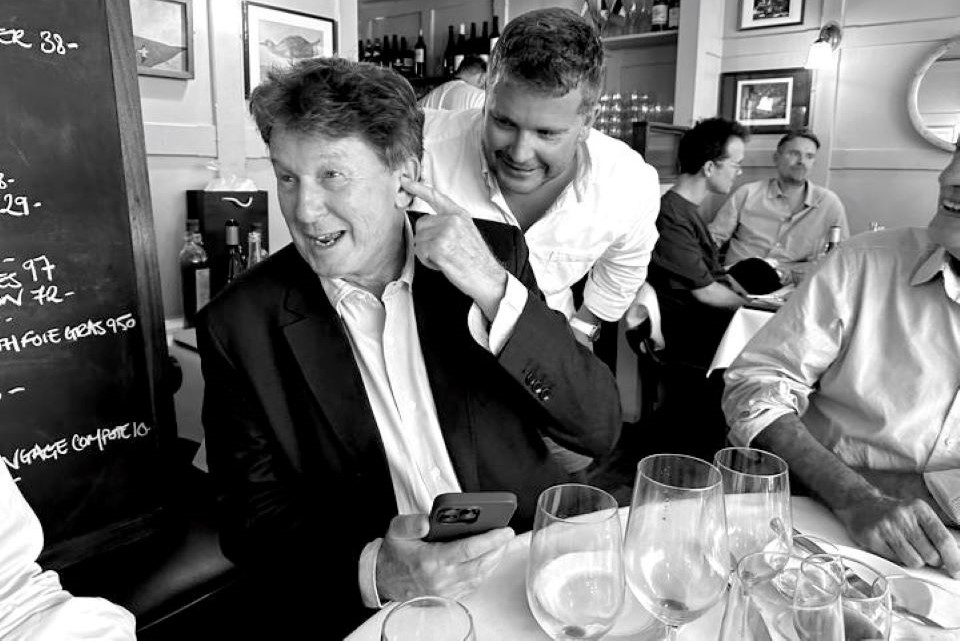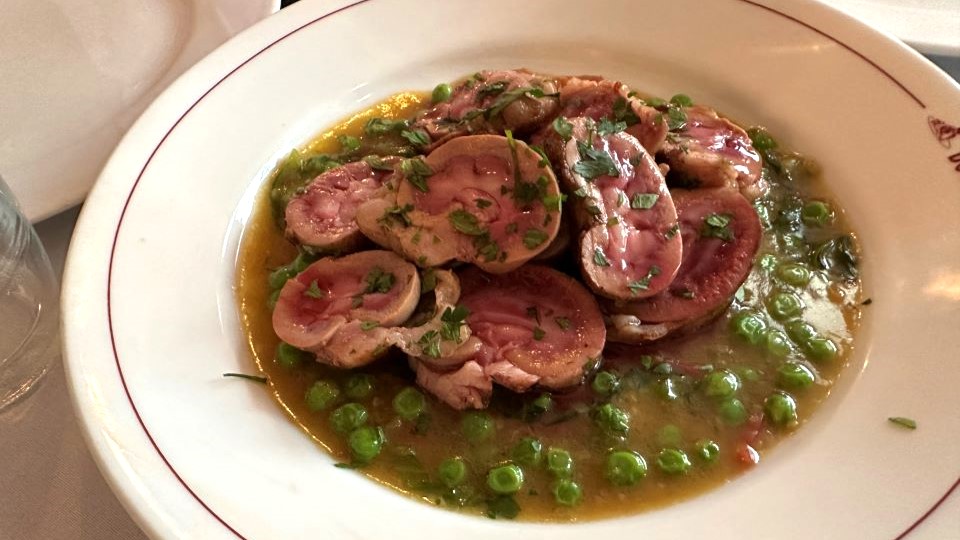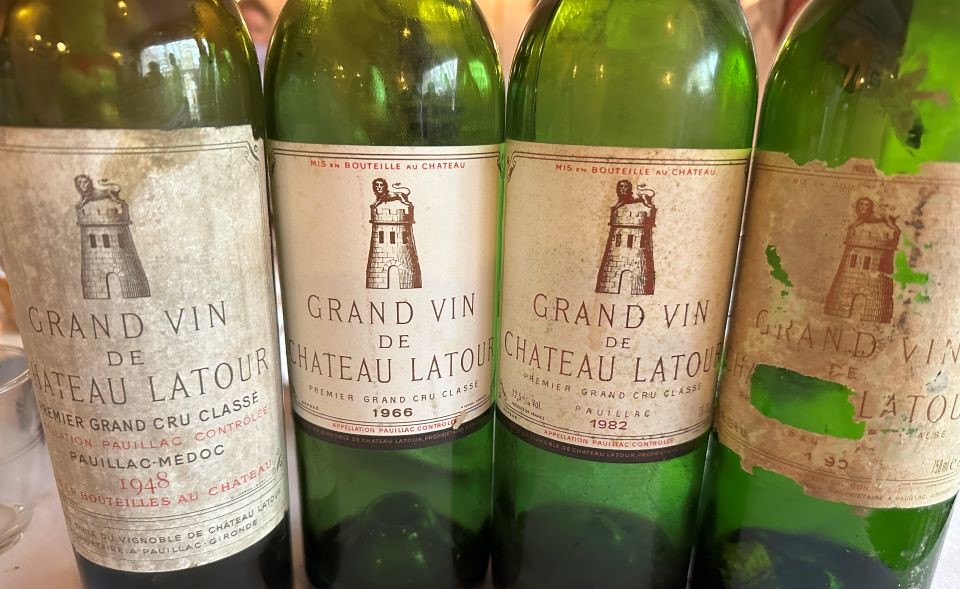Browse using the new Vinous website now. Launch →
Printed by, and for the sole use of . All rights reserved © 2015 Vinous Media
66 Cowcross Street
London EC1M 6BP
BY NEAL MARTIN | OCTOBER 25, 2024
The Food:
Jambon de Bayonne with Charentais melon
Calf’s brains with black butter and capers
Rabbit with mustard sauce and smoked bacon
Milk-fed lambs’ kidneys with peas à la Française
Tête de veau with sauce Ravigote
Pork chop, piperade with sweetcorn and tarragon
The Wines:
| 2013 Pewsey Vale Vineyard Riesling The Contours | 88 |
| 2021 Danbury Ridge Wine Estate Chardonnay | 90 |
| 1962 Marqués de Riscal Gran Riserva | 92 |
| 1948 Latour | 91 |
| 1966 Latour | 97 |
| 1982 Latour | 99 |
| 1990 Latour | 95 |
Bellamy’s
These five restaurants and one abode have hosted previous editions of Grouse Club dinners. Grouse Club started from a whimsical idea. Three friends shared a passion for the bird, fine wine and conversation late into the night.
It’s a blend of camaraderie and sealing years of friendship.
Grouse Club has gained a reputation across the wine community to the point where two places were auctioned for charity this year with The Stuart Broad Appeal in aid of Motor Neurone Disease. In fact, one guest had read about Grouse Club on Vinous and wanted to join the fun. All I can say is thank you for your generosity.
This year, we decided that there was only one restaurant that befitted the grouse – Bouchon Racine.
Just one problem…
… there was no grouse.
As if the game bird had enough problems avoiding bullets, the wet and cold spring on the moors decimated breeding. Exacerbating the problem, grouse are becoming tolerant to a pellet that inoculates against a worm that kills adult birds. Plus, there are depleted numbers of heather beetles, their main food source. A combination of this means that in 2024, a vast number of shoots were canceled to rebuild numbers, and chef Harry Harris had to provide alternatives.
Having regaled Bouchon Racine, there is little point in going over the menu again. Suffice it to say that this is your Lyon bistro brought to central London. I have just photographed some of the highlights below…
This
rabbit with mustard sauce and smoked bacon was packed with flavor, and the
sauce was not too strong on the old “Dijon” that could interfere with the wine.
These
milk-fed lambs’ kidneys with peas à la Française are rich and gamey, the
closest we could get to recreating our missing grouse.
These
pork chops came with piperade with sweetcorn and tarragon. Fabulous.
We commenced with a 2013 Riesling The Contours from Pewsey Vale Vineyard in the Eden Valley. This has a silvery hue. It offers fine delineation and is quite lively. The 2013 offers subtle petrol scents mixed with melon and lemon sherbet. The palate has notable acidity and is sharp and steely for an Australian Riesling. Sour lemon and lime towards the finish; it is difficult to see how or indeed whether this will evolve with continued bottle age. The 2021 Chardonnay from Danbury Ridge Wine Estate was poured blind and replicated its showing from earlier this year. With yellow plum, Clementine and freshly sliced lime on the nose, it could pass as a decent Saint-Aubin. The palate is fresh and well-balanced with a keen bead of acidity, showing similar tension to the Pewsey Vale Riesling but with more substance and grip on the finish. Essex’s finest! Commencing the reds, a 1962 Gran Riserva from Marqués de Riscal was opened. This Rioja offers brown spices, oxtail and tobacco on the nose. It is fully mature yet still well-defined and a bit ragged yet charming. The palate is a little Burgundian in style, with a core of sweet red fruit mixed with leather, sage and truffle. It is a more elegant Gran Riserva, softened by time, though it just attenuates on the finish, whereas a superior vintage like the 1964 would possess more substance. Still, well-kept bottles will continue to give pleasure.
The main event was the quartet of Château Latour vintages. Exceptionally well-stocked cellars often have bottles that always show splendidly, even better than those poured at the property. This collection is filled with enticing bottles, and I was very grateful for them.
The 1948
Latour was the first vintage to be poured, and this time, I had a proper
glass. (Unfortunately, when I had drunk this 12 months earlier, the waiter
accidentally omitted my glass while I was ensconced in conversation and only realized
once the entire bottle had been poured.) Not this time. The 1948 is rather
introverted at first, though it improves with aeration, a mixture of red and
black fruit, leather, black truffle and cedar. It is not a powerful bouquet,
yet there is presence. The palate is marked by relatively lighter tannins for
this particular First Growth, black fruit laced with pencil shavings and
undergrowth. Maybe there is just a little dilution on the finish, but you
cannot deny its refinement and statesmanlike personality. Bottles should be
opened unless you are lucky enough to find larger formats. The 1966 Latour
has been one of my favorite vintages from the decade for many years. This is
one of the finest examples that I have encountered. The bouquet is captivating:
blackberry, pencil box, touches of blue fruit, exquisite delineation and focus,
gaining stature with every swirl. The palate is typically 1966, sturdy and
structured, though time has softened those tannins, making it a little less
aloof than a decade ago. There is unerring symmetry to this Latour with a
detailed, classically styled, off-dry finish that beckons you back for more.
The 1982 Latour is a formidable wine. I really don’t know what I can add to previous tasting notes apart from it is a majestic, powerful, regal First Growth that is endowed with stunning symmetry and, rare for Latour, sensuality. At 42 years of age, it is unquestionably the most consistent of the five First Growths, and only Mouton Rothschild can trump it. Then again, unlike Latour, you never know what kind of 1982 Mouton you will open. Finally, the 1990 Latour is a vintage that I have not drunk for five years. It is surprisingly youthful on the nose, with dense black fruit, cedar, violet petals and graphite, and it is less opulent than previous bottles. The palate is medium-bodied with beautiful poise, and the tannins are more polymerized than the magnum poured in Bordeaux in 2019, though still extremely long and composed on the finish. It is drinking perfectly now and will continue to do so for many years.

Does
the wine go in here? No, Lord Bruce, the mouth is much better. Pictured with
fellow Grouse Club member Gareth “Marathon Man” Birchley.
The 7th edition of Grouse Club was over. Bouchon Racine continues to serve outstanding Lyonnais-inspired dishes and attracts gourmands from afar. Indeed, the team from Noble Rot was at the adjacent table and probably wished they had booked a different day.
Frankly, there are far greater problems in the world than no longer being able to dress in tweed and pay an extortionate amount to blast a defenseless bird. Whatever happens, we will uphold our annual tradition even if hunters cannot maintain theirs.
© 2024, Vinous. No portion of this article may be copied, shared or re-distributed without prior consent from Vinous. Doing so is not only a violation of our copyright, but also threatens the survival of independent wine criticism.




